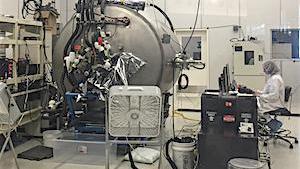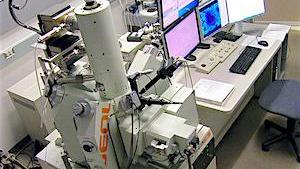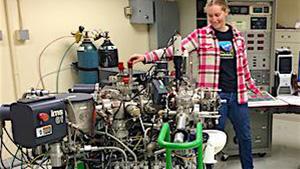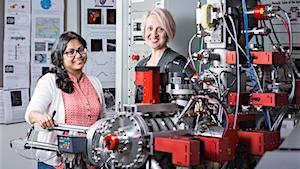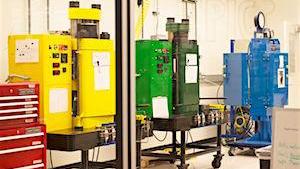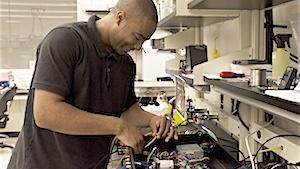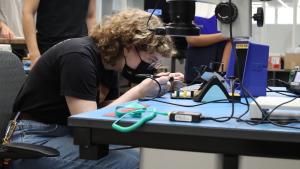The School of Earth and Space Exploration is home to more than 40 instrument facilities and laboratories, led by our faculty in the Earth and space fields including geological science, planetary science, astronomy, cosmology, astrobiology, astrophysics, exploration systems design, and science education. Move below for more detailed descriptions to the facilities and laboratories available to our faculty, research staff, graduate students, and undergraduates.
Previous Labs of the Month
In the Hydrothermal Organic Geochemistry (HOG) Lab, Professor Everett Shock is one of the researchers who study underwater environments dealing with hydrothermal ecosystems and how geochemical interactions on Earth can be applied to new environments, including other planets. While temperature, data and samples are collected at the site location, the HOG lab allows researchers to recreate the temperatures and pressures of unique biomes. Watch this video to take a lab tour.
Located on the ASU Tempe campus, in a glass-walled room in the lobby of Interdisciplinary Science and Technology Building IV, is the Mars Mission Operations (mission ops). Mission ops is equipped with large monitors showcasing the latest images from Mastcam-Z and the Mars 2020 mission. Visitors to the lobby can often see the team hard at work, assessing and reviewing data received from the rover Perseverance. Data is archived, making sure all of the images that were commanded are downlinked, and checking for image focus, saturation and pointing of the cameras. Ultimately, this team is also responsible for creating the image mosaics and videos of Mars for the science team and the public. Check out panoramas and mosaics from Mastcam-Z.
The 100K and 10K cleanroom facilities located within the Interdisciplinary Science and Technology Building 4 (ISTB4) are spaceflight-certified cleanrooms for assembly and testing of instruments and spacecraft for missions beyond Earth. The 100K cleanroom also features a thermal vacuum test chamber in which instruments and spacecraft can be tested under the temperature and vacuum conditions they will experience in space. Watch this video.
In the Low-frequency Cosmology (LoCo) Lab, research students and faculty collaborate to develop radio instrumentation and conduct astronomical observations to study the evolution of the early Universe and the first stars and galaxies. They apply their technical experience in large data analysis to study new approaches for helping improve science learning and public outreach. The LoCo Lab team is engaged in mentoring, teaching, and sharing their excitement for science and technology with the community. Explore more and read about their projects.
The Metals, Environmental and Terrestrial Analytical Laboratory (METAL) is a dual-location analytical facility with the instruments and resources to support research across many fields, including anthropology, chemistry, biology, forensics, geology, environmental studies, and ecology. The laboratories accommodate sample processing and analyses from industry, academia, and government researchers. Tour inside the lab and discover the equipment and instrumentation used to support scientific advances for students and researchers across disciplines at ASU as well as external users.
The Interplanetary Initiative Lab is an interdisciplinary research and development workspace committed to innovation and discovery. The lab is open to ASU students, faculty and staff, and external partners to design, build and test space hardware and software. View the website to discover the 6,800 square-foot "space makers space" offering cutting-edge space-industry technology.
In the Center for Isotope Analysis, the primary scientific instrument is the NanoScale Secondary ion Mass Spectrometer (NanoSIMS). Used to determine the chemical or isotopic makeup of geological and extraterrestrial samples, the primary advantage of the NanoSIMS over other analytical tools is its ability to deliver high spatial resolution even on areas smaller than 1 micron. Watch this video for a behind the scenes look inside the NanoSIMS lab.
In the Secondary Ion Mass Spectrometry (SIMS) Lab, Professor Richard Hervig investigates the elemental and isotopic chemistry of Earth and extraterrestrial materials on a microscale with the goal of interpreting the origin and evolution of these materials. Watch this lab tour video and learn how samples from solar winds and meteorites to volcanic materials are processed and analyzed.
In Associate Professor Dan Shim’s High Pressure Diamond-anvil Lab, researchers seek to understand the inner workings of planets by studying planetary materials (hydrogen, water, silicates, oxides, hydroxides, carbides, hydrides, and metal alloys) at a wide range of pressures and temperatures. One technique uses the diamond-anvil cell, where a tiny spec of a mineral is placed between two diamond anvils that are squeezed together to mimic the temperature and pressure inside the core of a planetary interior. Watch this video to discover research activities and a peek inside the lab facility.
In Hilairy Hartnett's biogeochemistry lab known as Carbon and Nitrogen Dynamics Lab or CaNDy LaB, researchers study carbon and nitrogen in all ranges of aquatic systems including the ocean, rivers and lakes, or very dry soils. Watch this video as students from the CaNDy LaB study the chemistry of Tempe Town Lake in ASU's own backyard.
In honor of Apollo 14’s lunar landing anniversary, the Lunar Reconnaissance Orbiter Camera (LROC) Science Operations Center is January's Lab of the Month. LROC is a system of three cameras mounted on the Lunar Reconnaissance Orbiter that capture high-resolution black and white images and moderate resolution multi-spectral images of the lunar surface. Watch principal investigator Mark Robinson explain the history and mission as LROC marks a decade of discovery. View stunning images and learn more from the LROC website.
School director Meenakshi Wadwha's Isotope Cosmochemistry and Geochronology Laboratory (ICGL) is one of only a few isotope laboratories in the U.S. dedicated to the analysis of meteorites. It consists of a 1,000 sq. ft. clean chemistry laboratory and a neighboring mass spectrometer facility. Watch this lab tour video and visit the lab website to learn more.
In Elizabeth Trembath-Reichert's Microbiology of the Deep (MOD) Lab, researchers study microbes living below the Earth’s surface, deep in the ocean, and deep below the ocean floor. The lab incorporates elements of microbial ecology, astrobiology geobiology, oceanography, and geochemistry to ask questions about the microbial role in Earth-life interactions. Watch this lab tour video and visit the website to learn more.
We are visiting volcanologist Amanda Clarke's Experimental Volcanology Lab, which integrates field observations, numerical models, and laboratory experiments of volcanic processes and serves as a center of collaboration and education. Watch this video as student researchers simulate the flow of lava using wax and recreate volcanic jets and plumes to simulate ash clouds spreading in the atmosphere.
| Instrument Facilities and Laboratories | Director or associated faculty member |
|---|---|
| 100K and 10K Cleanroom Facilities | Philip Christensen |
| Aberration Corrected Transmission Electron Microscope | Tom Sharp |
| Accessory Minerals (Apatite, Zircon) IN-situ Geochronology/geochemistry lab (AMAZING) | Melanie Barboni |
| Anbarlab | Ariel Anbar |
| Astrobiology, Molecular Biology, and Proteomics Lab | |
| Carbon and Nitrogen Dynamics Lab (CaNDy LaB) | Hilairy Hartnett |
| Center for Education Through eXploration | Ariel Anbar |
| Center for Meteorite Studies | Meenakshi Wadhwa, Laurence Garvie |
| Cosmogenic and Short-Lived Isotopes Lab | Arjun Heimsath |
| Distributed Robotic Exploration and Mapping Systems Lab (DREAM) | Jnaneshwar Das |
| Dryland Ecosystems Lab | Heather Throop |
| Earth Surface Processes and Geomorphology Lab | Ian Walker |
| Engineering Flight Hardware Lab | Philip Christensen |
| Experimental Petrology and Igneous Processes Center (EPIC) | Christy Till |
| Experimental Volcanology Lab | Amanda Clarke |
| Eyring Materials Center Electron Microprobe | Tom Sharp, Axel Wittmann |
| GEOPIG Biogeochemistry Lab | Everett Shock |
| Group 18 Labs | Kip Hodges |
| High Pressure Diamond-anvil Lab | Dan Shim |
| Hubble Data Lab | Rogier Windhorst |
| Hydrogen Gas Loading Facility | Dan Shim |
| Hydrothermal Organic Geochemistry (HOG) Lab | Everett Shock |
| Isotope Cosmochemistry and Geochronology Lab | Meenakshi Wadhwa |
| John M. Cowley Center for High Resolution Electron Microscopy | Peter Buseck, Tom Sharp |
| Laboratory for Astronomical Space Instrumentation | Paul Scowen |
| Low-frequency Cosmology Lab | Judd Bowman, Danny Jacobs |
| Lunar Polar Hydrogen Mapper Development and Test Lab | Craig Hardgrove |
| Lunar Reconnaissance Orbiter Camera Science Operations Center | Mark Robinson |
| Mars Space Flight Facility | Philip Christensen |
| Metals, Environmental and Terrestrial Analytical Laboratory (METAL) |
Gwyneth Gordon |
| Mission Operations Facility | Jim Bell |
| Microbiology of the Deep (MOD) | Elizabeth Trembath-Reicher |
| Multi-anvil Press Lab | Dan Shim |
| OSIRIS-REx Thermal Emission Spectrometer Lab | Philip Christensen |
| Planetary Aeolian Lab | David Williams, Ian Walker |
| Planetary GIS Lab | David Williams, David Nelson |
| Planetary Surface Imaging Science Lab | Jim Bell |
| Planetary Surfaces Spectroscopy Lab | Jim Bell |
| Ronald Greeley Center for Planetary Studies | David Williams |
| Secondary Ion Mass Spectrometry Lab (SIMS) / Nanoscale Secondary Ion Mass Spectrometry Lab (NanoSIMS) | Rick Hervig, Maitrayee Bose |
| Terahertz Instrumentation Lab | Chris Groppi, Phil Mauskopf |
| W.M. Keck Foundation Lab for Environmental Biogeochemistry | Everett Shock, Ariel Anbar, Meenakshi Wadhwa |
Instrument Facilities and Laboratories
The instrument facilities and laboratories available to our faculty, research staff, graduate students, and undergraduates include:
100K and 10K Cleanroom Facilities
The School's home, the Interdisciplinary Science and Technology Building 4 (ISTB4), contains laboratories and two spaceflight-certified cleanrooms for assembly and testing of instruments and spacecraft for missions beyond Earth. One cleanroom is rated at 100K (no more than 100,000 dust particles per cubic meter), the other is rated at 10K (no more than 10,000 particles).
The cleanrooms contain optical benches and vibration-isolated tables for assembling precision optical and mechanical parts for instruments and spacecraft. In addition, the 100K cleanroom also features a thermal vacuum test chamber (above) in which instruments and spacecraft can be tested under the temperature and vacuum conditions they will experience in space.
Eyring Materials Center
The Eyring Materials Center (formally known as the LeRoy Eyring Center for Solid State Science) was established in 1974 to provide researchers with open access to sophisticated techniques for materials characterization and high-resolution electron microscopy. The Center supports materials analysis across a broad range of scientific disciplines, including physics; chemistry; biological sciences; earth/space sciences; and engineering.
The center houses three aberration-corrected Transmission Electron Microscopes (TEMs) to image and analyze the chemistry and structure of materials at sub-angstrom resolution. The Center’s electron microprobe is capable of high-resolution imaging and is equipped with detectors that allow chemical analyses of sub-micrometer domains of solid materials.
Secondary Ion Mass Spectrometry (SIMS) Laboratory
The laboratory's mission is to conduct research in the general fields of quantitative secondary ion mass spectrometry. This includes research in ion source design, improvements in secondary ion transmission, alternate uses of the sensitive mass spectrometer, conventional SIMS analysis in earth and materials science, and to offer high-quality SIMS analyses to NSF-funded geoscience researchers.
Nanoscale Secondary Ion Mass Spectrometry (NanoSIMS) Laboratory
ASU is home to a state-of-the-art NanoSIMS instrument, one of only a dozen in the United States. The NanoSIMS is a nanoscopic scale resolution chemical imaging mass spectrometer based on secondary ion mass spectrometry. It works based on a coaxial optical design of the ion gun and the secondary ion extraction, and on an original magnetic sector mass spectrometer with multicollection. ASU’s NanoSIMS can map elemental and isotopic distributions in samples with exceptional sensitivity and spatial resolution better than 50 nanometers.
Experimental Petrology and Igneous Processes Center (EPIC)
The Experimental Petrology and Igneous Processes Center is designed to study magma: how and why it forms, its composition and timescales, and the resulting consequences for planetary differentiation. Researchers in this lab study volcanoes and their magma source regions, conduct high pressure and high temperature experiments to simulate magma formation, and perform computational modeling of magmatic processes.
The lab facilities include two Kennedy-style end loaded piston cylinders with automated temperature controllers, a Boyd-England-style Rockland Research 250-ton piston cylinder with automated pressure and temperature controllers, a 10-ton Press for experimental capsule extraction, an Atmosphere Gas Mixing Furnace, a Lampert TIG welder, two Nikon SMZ18 Stereomicroscopes, a Nikon LV100 Petrographic Microscope with camera, Buehler & Struers Low Speed Saws, a Well-brand wire saw with diamond wire, and a Struers LaboSystem automated polisher.
Radio Instrumentation
Low-frequency Cosmology Lab (LoCo Lab)
The Low-frequency Cosmology Lab is designed to develop radio instrumentation and conduct astronomical observations to study the evolution of the early Universe and the first stars and galaxies. Current projects include The Experiment to Detect the Global EoR Signature (EDGES), which enables high-precision measurements of the smoothness of the all-sky radio spectrum between 50 and 200 MHz (6<z<30), placing limits on the global 21-cm contribution to the all-sky spectrum and the Hydrogen Epoch of Reionization Array (HERA) under construction in South Africa to enable the first detailed measurements of the redshifted 21cm power spectrum from reionization.
Terahertz Instrumentation Lab
In the terahertz lab in the School of Earth and Space Exploration at ASU, we specialize in the design, construction and deployment of THz and similar frequency electronics for astrophysics and other remote sensing applications.
Interplanetary Laboratory
The Interplanetary Initiative is a university-wide center, building the future of humans in space. The Laboratory is a Space Maker Space that supports related projects from art projects to small satellites. The six thousand square foot facility in Sun Devil Hall on the Tempe campus includes co-work, electronics, fabrication, and environments test facilities. Test capabilities include vibration, thermal vacuum, clean assembly, attitude control, and operations. The lab is operated by a staff of ASU students and additional support from staff engineers is also available. Lab membership is open to all ASU students and faculty after training. Membership is open to commercial and non-governmental partners for a small fee. Support for projects is available with application to the Initiative. For more details visit the website and send inquiries to iilab@asu.edu.
Telescopes, Instruments, and Other Observational Facilities
The school's researchers have access to a broad suite of world-class telescopes and instruments through the Arizona telescope system, along with access to national ground- and space-based facilities. The Arizona telescope system provides access to the 11 meter equivalent Large Binocular Telescope on Mt. Graham, the 6.5 meter MMT on Mt. Hopkins, the 2.2 meter Bok telescope on Kitt Peak (all in Arizona), and the twin 6.5 meter Magellan telescopes at Las Campanas Observatories in Chile, along with several smaller telescopes. Time on these facilities is allocated through a single unified process for all three of Arizona's state-supported universities (ASU, U of A, and NAU). ASU is also a partner in the Giant Magellan Telescope project, under construction at Las Campanas in Chile.
These facilities have a large suite of state-of-the-art instruments, providing both imaging and spectroscopy at both optical and near-infrared wavelengths. Adaptive optics and interferometry are under active development for the MMT and the LBT, and will allow high angular resolution astronomy from Arizona mountaintops in the near future. School of Earth and Space Exploration researchers can also apply for time on Arizona radio telescopes, notably including the 12 meter diameter millimeter-wave dish on Kitt Peak, and the 10 meter Heinrich Hertz Submillimeter Observatory on Mt. Graham.
Computational and Theoretical Resources
In-house high-performance computing — anchored with the 5,000 core, 10TB RAM Saguaro cluster in which the school owns 25 percent — places our researchers at the forefront of numerical astrophysics. The school's scientists use the Saguaro cluster for numerical simulations with a variety of tools, including smooth particle hydrodynamics (the SNSPH and GADGET-2 codes) and adaptive mesh refinement hydrodynamics (the FLASH and PROMPI codes). These resources and tools allow us to study the formation and evolution of objects on scales ranging from 100 Mpc or more (a region larger than the local universe) to an individual neutron star (about the size of Tempe).
Laboratory and Instrument Development Resources
The Laboratory for Astronomical and Space Instrumentation (LASI) offers access to clean room space (class 1000K, 100K, and 10K, with over 3000 square feet per class). It also provides a fully functional optical testbed for QE, linearity and cosmetic testing of detectors over wavelengths from the mid-UV to the near-IR as well as hardware assembly and associated electronics integration. Proximity to the ASU Machine Shop (which has produced space-qualified hardware for Mars missions) offers quick custom machining and integration of pieces in instrument assembly.

